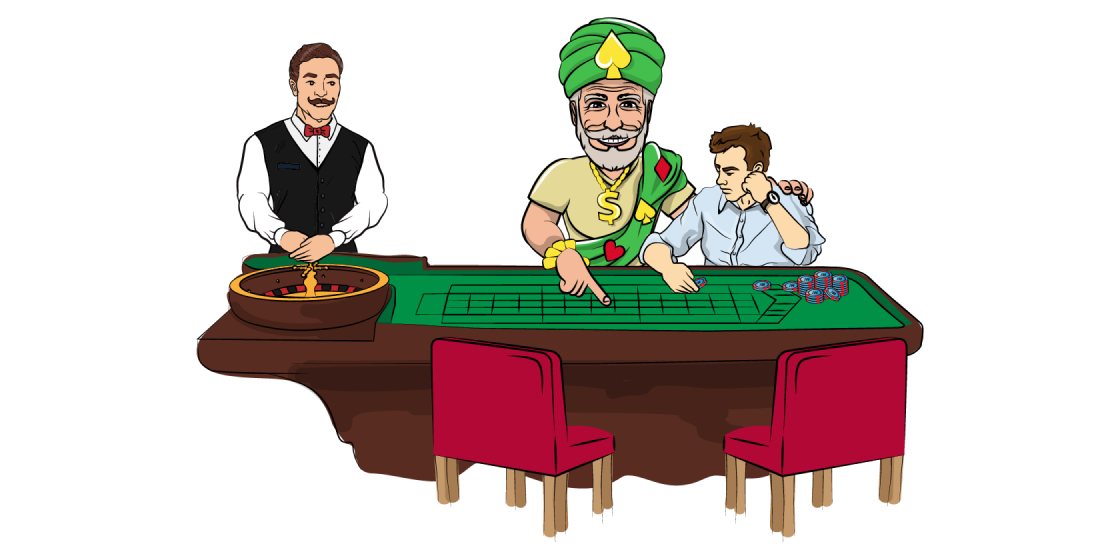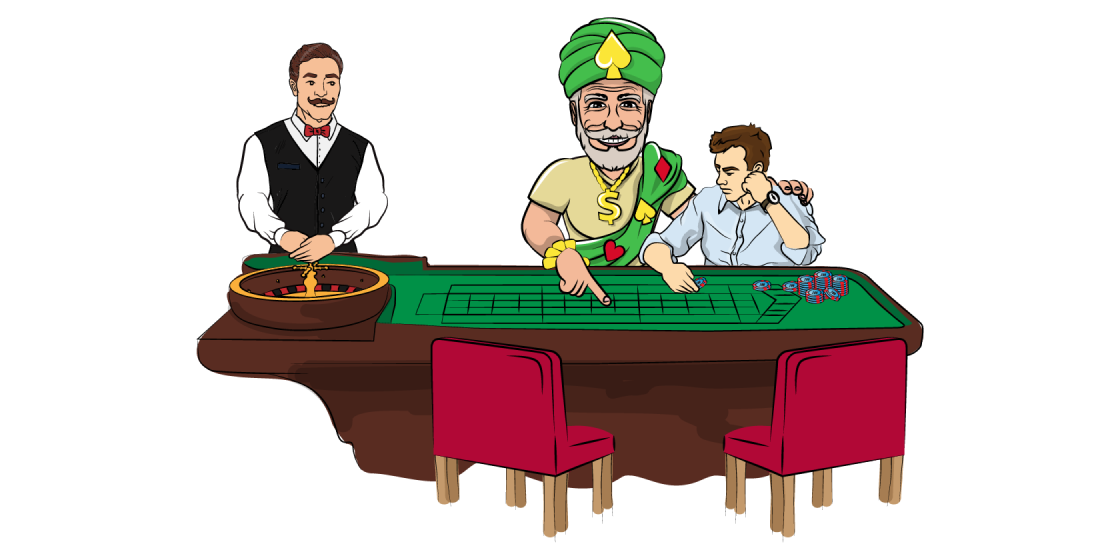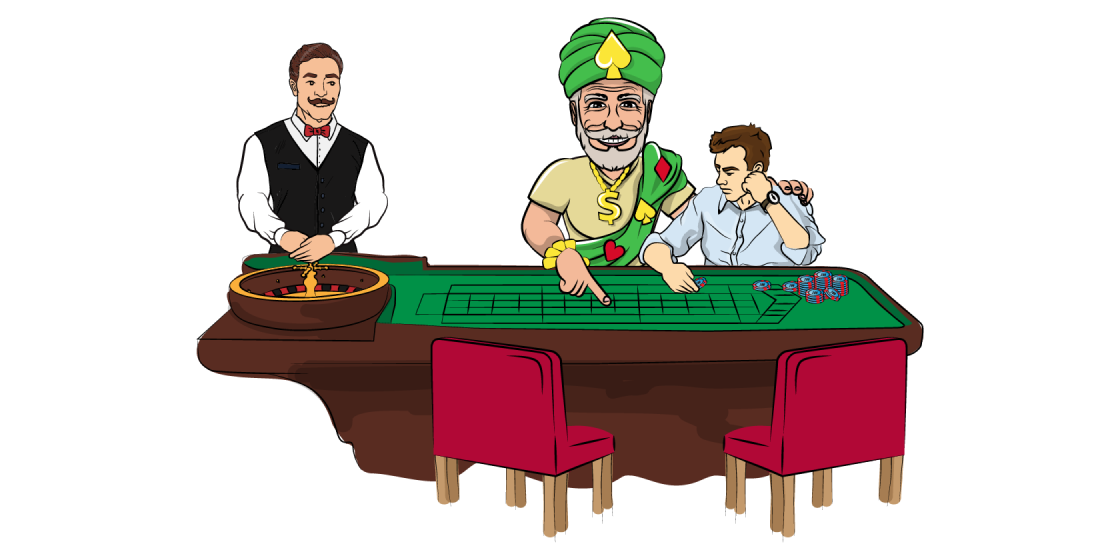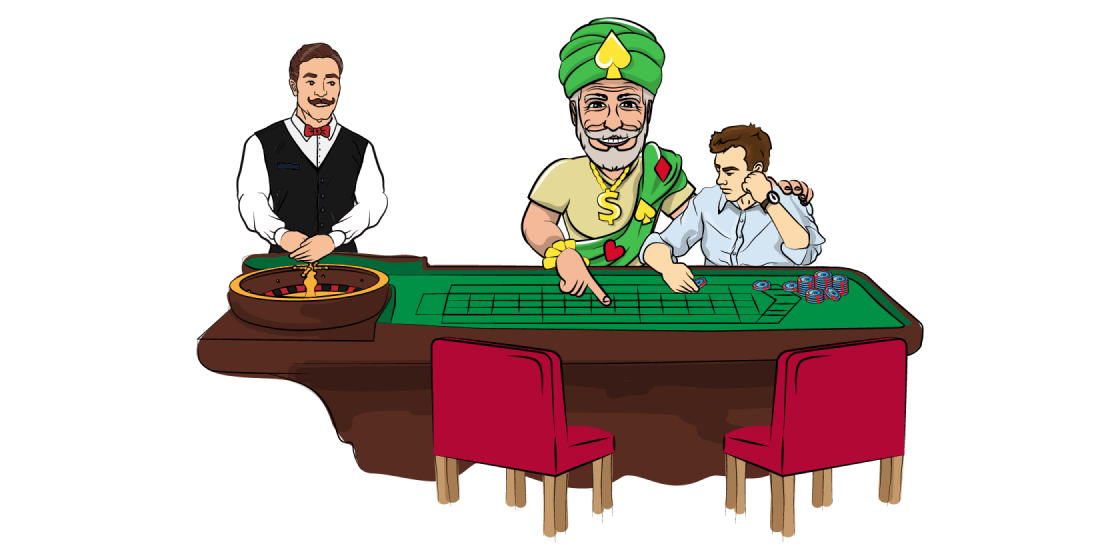Reverse Martingale Roulette Strategy
Before we get started, I’d like to point out that this is the best roulette strategy there currently is, in my opinion. It excels because of the foreseeable amount of time you get to play, the high return for players, and the chance of potentially getting massive wins. I will get to that later on.
The Reverse Martingale strategy takes its name from the infamous Martingale strategy, which consists of increasing your bet size after each loss. The Reverse Martingale strategy is the opposite of this. Instead of increasing the bet size after each loss, you increase it after each win with the aim of turning a short streak of winning game rounds into a massive win.
Keep reading this article and find out:
- why I think this is the best and most balanced roulette strategy there is;
- how it works in action (supported by simulations);
- how you can use high volatility to your advantage through this strategy,
- what the possibility is of turning $10 into more than $4,500 using this system.
How the Reverse Martingale strategy works
The Reverse Martingale strategy is relatively simple to use. I’ll try to summarize it in just a few steps:
- You choose your starting bankroll and the amount you would like to leave the casino with – the target amount.
- You start by wagering a small part of your bankroll during each roulette spin. This will be your "basic bet". The choice of bet types is up to you, but with some bets being better than others, as I will demonstrate in my simulations later on.
- Every time you win you wager the entire amount you’ve just won all over again (including your original bet). Every time you lose, you go back to placing your basic bets.
- You repeat this process until you lose your entire bankroll or reach your target amount.
To make this strategy a bit clearer, here’s a simple example of what the Reverse Martingale roulette strategy might look like in action. Let’s say a player starts with $100, and places $1 basic bets on a Straight Up number. This player would like to walk away with at least $1,000. They lose their first 27 spins, but then manage to win a spin, resulting in a $36 win (including their original stake). The player places this $36 on a Straight Up number, and loses. They then go back to placing their basic bets of $1 until they lose everything or win two spins in a row, which would move their bankroll over their target amount ($1 * 36 * 36 = $1,296).
As you might have already noticed, this strategy has only two possible outcomes. You either lose your entire bankroll, or manage to win a satisfying amount. The Reverse Martingale strategy is very similar to the All-in roulette strategy from this point of view. The Reverse Martingale strategy can be seen as many rounds of the All-in strategy, played one after another, but with a much smaller budget in each instance.
Before using the Reverse Martingale roulette strategy, you’ll first have to decide:
- how much money you are willing to (and can afford to) lose in one session – your bankroll;
- what your basic bet will be;
- what type of bets you are gong to place;
- how much you would like to win – your target amount.
Your chances of succeeding (i.e. reaching the target amount) depends on these factors. In the simulations detailed later in this article, multiple combinations will be tested in order to calculate the probability of winning, including the long-term return to the player for each of these combinations.
Not wagering the entire win at once
The idea of wagering the entire win from the previous spin, in just one game round, might seem too risky for some players even though it’s statistically the best option. There is also an option to wager just a part of the winnings after each win instead of wagering the entire previously won amount.
For example, instead of betting the basic $1 bet on a number and then betting the entire $36 immediately after a win, you could place an $18 bet, or even just a $12 bet. Simply speaking, you choose the percentage of each win you would like to wager again, and then stick to it. Let’s say you choose to bet 50% of each previous win. After winning the first spin, you decide to bet $18. The potential win from that spin would be $648, so your next bet size in succession would be $324.
This version of the Reverse Martingale strategy might be more attractive to some players because they don’t have to immediately place all of their winnings during the next spin. This is inferior to the "classic" version of the Reverse Martingale strategy, however, in terms of expected value.
The idea of not wagering the entire win at once has actually been made into a separate strategy, which is also very interesting, and might be more suitable for some players in comparison to the Reverse Martingale strategy. We decided to call it the Progressive Bet strategy. Check it out and decide for yourselves which option you find more interesting.
Advantages of the Reverse Martingale strategy
AT the beginning of this article I stated that, in my opinion, this is the best roulette strategy there is. This is a strong claim, which is why I think it’s necessary to present the reasoning behind my opinion.
As I mentioned in the main article on roulette strategies, my strategies are based on finding a balance between four factors. The Reverse Martingale strategy is great because it ranks well for all of these factors:
- RTP (Return to Player) – The Reverse Martingale Strategy has great expected return, enabling you to play through your bankroll by placing basic bets, and only place higher bets in a limited number of cases. The lower wagered total amount results in a significantly better average return.
- Chance of winning big – With the Reverse Martingale strategy you have a really reasonable chance of getting a big win, depending on the target amount you would like to win. Remember, however, that the higher you set the target amount, the lower your chances of actually hitting it.
- Play time – Due to the nature of this strategy, expected play time is largely predictable. I will focus more on this later on.
- Thrill – The thrill factor of the Reverse Martingale strategy is also amazing. Most of the time you’ll be placing small basic bets, but every once in a while (if you place Straight Up bets) or quite often (if you place your bets on Color) you’ll get to place higher bets with the potential of winning big.
All of my strategies rank well in at least some of these factors. The Constant Bet strategy and the Constant Proportion strategy do well in terms of play time, but the chances of winning big are very small and their RTP tends to get quite low the more the bet sizes increase, in addition to the thrill factor being rather lackluster.
The All-in strategy has great RTP, a good chance of winning big and a huge thrill factor (which is too high for most people), but you’ll only get to play one or two spins in most cases, which means the play time is not that great if you want to enjoy the game for a decent period of time.
The balance of the aforementioned four factors is what makes the Reverse Martingale strategy the best in my opinion. I am not saying it’s the best option for everybody, but I’m pretty sure it’s the best overall option, which you should definitely consider if you are looking for an efficient and enjoyable way to play roulette.
Potential issues with bet size limits
When using the Reverse Martingale strategy you might run into issues with bet size limits at the brick-and-mortar or online casino you play at. Just as with the All-in strategy, the bet sizes increase quite rapidly when you are winning, which means the bet limits might be a problem if you don’t plan them in advance.
Just as I mentioned in my article on the All-in roulette strategy, make sure you check the table limits before you start playing so that you pick a specific bet type and target amount you can actually go through with. If you find out that the bet size limits could prevent you from reaching your target amount, you should reconsider your strategy and change your target amount.
I am aware of the fact that most people reading this article play casino games online, so I thoroughly checked online roulette bet size limits and struggled to find an example in which you can bet more than $500 Straight Up or $20,000 on a Color. There are online casinos with higher bet size limits, but access to these might be limited by your VIP status or your current balance. With this in mind, I tried to limit the amounts used in my simulations to levels achievable by recreational players, which could then be used in real life.
Achievable amounts
The Reverse Martingale strategy is all about trying to multiply the basic bet as many times as needed in order to reach a predetermined target amount. By purposefully creating a sequence of different bet types, it’s possible to get close to any nice and round multiple of your initial bankroll. This is demonstrated in the table below.
| Desired win using a $1 basic bet | Bet sequence | Potential win calculation |
|---|---|---|
| $200 | Straight up – Six line | $1 * 36 * 6 = $216 |
| $500 | Straight Up – Split | $1 * 36 * 18 = $648 |
| $1,000 | Straight Up – Straight up | $1 * 36 * 36 = $1,296 |
| $2,000 | Straight Up – Straight Up – Color | $1 * 36 * 36 * 2 = $2,592 |
| $3,000 | Straight Up – Straight Up – Dozen | $1 * 36 * 36 * 3 = $3,888 |
| $5,000 | Straight Up – Straight Up – Six line | $1 * 36 * 36 * 6 = $7,776 |
| $10,000 | Straight Up – Straight Up - Corner | $1 * 36 * 36 * 9 = $11,664 |
| $20,000 | Straight Up – Straight Up – Split | $1 * 36 * 36 * 18 = $23,328 |
Expected time of play
One of the advantages of the Reverse Martingale strategy is the expected play time, which is highly predictable and doesn’t change that much. Due to its nature, this strategy is calculable to a great degree of precision.
When calculating the expected time of play, it’s necessary to consider the two kinds of spins that you’ll get to play:
- The number of spins through which you get to place your basic bets is fixed, and is only dependent on the ratio between your basic bet and your bankroll. If you go into the game with $100 and place basic bets of $1, you’ll play 100 of these game rounds.
- The number of spins in which you get to place higher bets, will depend on the type of bets you place. If you place your bets on a Straight Up number, you’ll only get to place a higher bet during one of the 37 one-dollar spins (statistically). If your goal is to win more than two bets in a row, you’ll have to calculate the chances of getting to the higher bets, which are continuously decreasing, but which still need to be included in your calculations.
Let’s take a closer look at the specific amount of play time for players using the Reverse Martingale strategy, and placing their bets on Color:
- The probability of placing the first spin at a bet size of $1 is 100%. That’s easy.
- Whether the player places the second bet ($2) in succession will depend on the outcome of the first spin. They only get to place this bet if they managed to win the first spin, which has a probability of 18/37 (roughly 48.65%).
- To play the third spin with a bet size of $4, the player needs to win the first two spins. This only has a probability of (18/37)^2 (roughly 23.67%).
- The probability of the player getting to the fourth spin is (18/37)^3 (roughly 11.5%).
- And so on and so on.
This progression is known as a geometric sequence in which its sum can be precisely calculated depending on type of bets the player places. The table below displays the expected total number of spins for different bet types.
| Bet type | Chance to win in each spin | Total expected number of spins for 100 basic bet spins |
|---|---|---|
| Color | 18/37 | 194.74 |
| Corner | 4/37 | 112.12 |
| Straight Up | 1/37 | 102.78 |
The expected number of spins in the table above is calculated using an infinite series, which means the results you get might (and most likely will) be at least slightly different. The number of spins you get to play might differ, but the differences should be quite small, especially after playing a large number of game rounds.
The numbers from the simulations should correspond with the numbers from the calculations. Let’s get to the simulations to see if they really do correspond.
Simulations for the Reverse Martingale strategy
Simulations are the best way to test the strategy’s effectiveness and efficiency in action. Real-life tests are an issue however due to the virtual impossibility of producing a sample size with a reasonable level of statistical significance. Let’s take a look at the simulations to see what kind of results the Reverse Martingale strategy brings.
Methodology and used variables
Before we get to the results themselves, it’s important to explain how the simulations were carried out, so that everything is completely clear.
First of all, the simulations were created using my own simulation software utilizing the rules and odds for single zero roulette, without any special rules in force such as En Prison or La Partage. Single zero roulette should always be used due to the much more favorable odds for the player, which results in higher a RTP strategy.
Here are the specifics of my simulations:
- The basic bet is always $0.1, with all players starting with a bankroll of $10 (100 spins with a basic bet) or $100 (1,000 spins with a basic bet).
- The players will always go through their entire number of spins when using a basic bet (100 or 1,000, depending on the bankroll) irrespective of their results. If they reach their target value, they simply set it aside and go back to the basic bet size to try their luck again. This means the players could reach their target value multiple times.
- The target values are different for each bet type, for a very good reason. Had I chosen the same target values for all simulations (like $100, $1000 etc.), the results would be biased because of the specific win amounts for each of the individual bet types.
Just as with all my other roulette strategy simulations, I included the following three bet types:
- Color – Red or Black (odds to win: 18/37, payout: 2x)
- Corner – Four numbers that share one corner (odds to win: 4/37, payout: 9x)
- Straight Up – One specific number (odds to win: 1/37, payout: 36x)
Remember that you can increase the numbers as long as the basic bet size and bankroll ratio remains the same. For example, a simulation with a $0.1 basic bet, a $10 bankroll and a target amount of $102.4 would have the same results as a simulation using a $1 basic bet, a $100 bankroll and a target amount of $1,024, as long as the bet type also remains the same.
For each bet type, initial bankroll and target amount, I simulated 1,000,000 runs. This sample size should be big enough to make the results statistically reliable, although it’s possible that there could still be some deviations in the runs with higher volatility. The results should be reliable enough, however, to draw solid conclusions.
Color bet simulations
Let’s start with the Color Bet type and a $10 bankroll, which is enough for 100 spins using the basic bet. Because bets on Color have very low volatility, players will have to win a higher number of spins in a row in order to get a decent win. Let’s see how many of them managed to do it.
| Target amount (# of wins needed) | Average number of rounds played | Average cost | Players winning 1 time only | Players winning 2 times | Players winning 3 times | Players winning 4 times | Players winning 5 times |
|---|---|---|---|---|---|---|---|
| $25.6 (8) | 194 | $1.97 | 229895 | 35765 | 3689 | 295 | 15 |
| $51.2 (9) | 194 | $2.15 | 131815 | 9991 | 456 | 30 | 1 |
| $102.4 (10) | 194 | $2.38 | 69028 | 2538 | 73 | 1 | 1 |
| $204.8 (11) | 194 | $2.6 | 34830 | 627 | 2 | 0 | 0 |
| $409.6 (12) | 195 | $2.85 | 17186 | 133 | 0 | 0 | 0 |
| $819.2 (13) | 195 | $3.12 | 8318 | 38 | 0 | 0 | 0 |
| $1638.4 (14) | 195 | $3.25 | 4105 | 7 | 0 | 0 | 0 |
| $3276.8 (15) | 195 | $3.35 | 2022 | 3 | 0 | 0 | 0 |
| $6553.6 (16) | 195 | $3.57 | 984 | 0 | 0 | 0 | 0 |
| $13107.2 (17) | 195 | $3.86 | 469 | 0 | 0 | 0 | 0 |
The following table displays the results of another run of simulations, but this time with a bankroll of $100, which is enough for 1,000 basic bet spins. This time the minimum target amount was set to $102.4 because that’s the first value that’s actually higher than the starting bankroll.
| Target amount (# of wins needed) | Average number of rounds played | Average cost | Players winning 1 time only | Players winning 2 times | Players winning 3 times | Players winning 4 times | Players winning 5, 6, 7 and 8 times |
|---|---|---|---|---|---|---|---|
| $102.4 (10) | 1945 | $23.9 | 353522 | 131043 | 32577 | 6136 | 907, 111, 12, 5 |
| $204.8 (11) | 1947 | $26.1 | 251218 | 45371 | 5568 | 491 | 29, 1, 0, 0 |
| $409.6 (12) | 1947 | $27.8 | 147772 | 13068 | 751 | 28 | 2, 0, 0, 0 |
| $819.2 (13) | 1947 | $30.1 | 78282 | 3372 | 98 | 3 | 0, 0, 0, 0 |
| $1638.4 (14) | 1947 | $31.4 | 40137 | 845 | 16 | 1 | 0, 0, 0, 0 |
| $3276.8 (15) | 1947 | $34.0 | 19709 | 199 | 0 | 0 | 0, 0, 0, 0 |
| $6553.6 (16) | 1947 | $35.5 | 9725 | 54 | 0 | 0 | 0, 0, 0, 0 |
| $13107.2 (17) | 1947 | $36.4 | 4842 | 5 | 0 | 0 | 0, 0, 0, 0 |
As you can clearly see, the number of winners and the average costs keep getting lower and higher, respectively, the more the target amount increases. This is, of course, pretty self-explanatory, as higher wins are less likely (hence lower numbers of winners), in addition to players having to place higher bets in order to achieve these wins, resulting in higher average costs. This will be similar for all bet types.
Corner Bet simulations
The second group of simulations follows players that place their bet on a Corner Bet type. Just as in the previous simulations, the first table contains results from simulations using a $0.1 basic bet and a $10 bankroll, which is enough for 100 basic spins.
| Target amount (# of wins needed) | Average number of rounds played | Average cost | Players winning 1 time only | Players winning 2 times | Players winning 3 times | Players winning 4 times |
|---|---|---|---|---|---|---|
| $72.9 (3) | 112 | $0.81 | 111008 | 7051 | 297 | 5 |
| $656.1 (4) | 112 | $0.88 | 13705 | 97 | 0 | 0 |
| $5904.9 (5) | 112 | $1.24 | 1481 | 1 | 0 | 0 |
| $53144.1 (6) | 112 | $1.39 | 162 | 0 | 0 | 0 |
The following table contains the results from simulations using a $0.1 basic bet and a $100 bankroll, which is enough for 1,000 basic spins. The target values start at $656.1, due to this being the first possible target value which is higher than the starting bankroll.
| Target amount (# of wins needed) | Average number of rounds played | Average cost | Players winning 1 time only | Players winning 2 times | Players winning 3 times | Players winning 4 times |
|---|---|---|---|---|---|---|
| $656.1 (4) | 1121 | $10.4 | 119102 | 8209 | 345 | 12 |
| $5904.9 (5) | 1121 | $13.7 | 14394 | 107 | 0 | 0 |
| $53144.1 (6) | 1121 | $14.1 | 1616 | 0 | 0 | 0 |
Straight Up bet simulations
The last two simulations focus on using the most volatile type of roulette bet – the Straight Up bet on a single number. Both tables have a basic bet size of $0.1, with the budget being $10 (100 basic spins) for the first table, and $100 (1,000 basic spins) for the second table.
| Target amount (# of wins needed) | Average number of rounds played | Average cost | Players winning 1 time only | Players winning 2 times | Players winning 3 times | Players winning 4 times |
|---|---|---|---|---|---|---|
| $129.6 (2) | 103 | $0.54 | 67932 | 2461 | 57 | 1 |
| $4665.6 (3) | 103 | $0.87 | 1952 | 2 | 0 | 0 |
| $167961.6 (4) | 103 | $1.27 | 52 | 0 | 0 | 0 |
| Target amount (# of wins needed) | Average number of rounds played | Average cost | Players winning 1 time only | Players winning 2 times | Players winning 3 times | Players winning 4 times |
|---|---|---|---|---|---|---|
| $4665.6 (3) | 1027 | $7.4 | 19511 | 170 | 1 | 0 |
| $167961.6 (4) | 1027 | $9.3 | 540 | 0 | 0 | 0 |
Results of simulations explained plus recommendations
When we look at the simulations for each individual bet type, it’s evident that the average cost keeps growing in relation to higher desired winnings. This is because of the need to place bigger bets to achieve greater wins, which also increases the costs.
In roulette, you statistically lose a portion of every bet you place (2.7% in European roulette), which is why bigger bets equate to higher long-term costs for the players. In fact, the average cost for each bet type and desired win can be precisely calculated by means of this formula:
Average cost (%) = 1 – (36/37) ^ (number of wins in a row needed to reach the target)
The probability of achieving the target amount is fair. The higher the target you set, the less likely you are to achieve it. That’s simply how statistics work in this case. If you want to win really big, you’ll have to accept the fact that you won’t win very often.
Comparison of bet types and their costs
The size of the target amount is entirely up to you due to it not being possible to objectively define which of them is the best. You are simply trading the possibility of a higher win for an increased average cost.
What can be objectively judged, however, is the bet type. When you take a look at the tables showing the results from my simulations, you can clearly see that the average costs are much higher when placing bets on Color. This is due to a bigger number of wins in a row being needed, a higher number of bets needing to be placed, and bet sizes tending to be higher.
The table below displays the simulation results for bet types of varying sizes, but with similar target amounts. Let’s take a look at these results so we can draw a clear comparison between the bet types and their average costs.
| Color | Corner | Straight Up | |
|---|---|---|---|
| Desired win | $102.4 | $72.9 | $129.6 |
| Number of wins needed in a row | 10 | 3 | 2 |
| Average cost | $2.38 | $0.81 | $0.54 |
| Number of winners (1x, 2x, 3x, 4x, 5x) | 69028, 2538, 73, 1, 1 | 111008, 7051, 297, 5, 0 | 67932,2461, 57, 1, 0 |
As you can clearly see, the "Straight Up" column has the highest desired win of the three examples, as well as having the lowest average cost. This is a clear sign that higher volatility yields better results, just as I’ve stated in my main article on roulette strategies.
I’ve previously mentioned that higher desired wins are connected to higher average costs, but that’s only true when the bet type remains the same. By moving to higher volatility bets, you can increase the desired win and decrease the average cost at the same time. If you are looking for maximum efficiency, you should definitely stick to the Straight Up bets.
The only reason to stick to the bets with lower variance is if you want to play a higher number of spins and have a bit more fun. The downside to using the most volatile Straight Up bet is having the lowest number of spins, and the fact that you only get to place higher bets very rarely, which might decrease the thrill factor to some degree.
If you’d like to have a few more spins you could try placing Corner Bets, but try to stay away from the Color Bet, as its average cost is so much higher.
Number of game rounds played
Earlier in this article I used a formula to calculate the total number of spins that players should make for each bet type. The simulations delivered the expected results, as clearly shown in the table below.
| Bet type | Calculated average # of spins | Recorded average # of spins (rounded) |
|---|---|---|
| Color | 194.74 | 195 |
| Corner | 112.12 | 112 |
| Straight Up | 102.78 | 103 |
Conclusion
The Reverse Martingale strategy really is the best strategy I can think of. For example, it gives you a realistic possibility of winning $4665.6 with an initial bankroll of just $10. Although the chance of achieving this is lower than 0.2%, the entire game will cost you only $0.87 on average. To my knowledge, there is no other roulette strategy with such a good ratio between the potential or winning and the average cost.
If you decide to try the Reverse Martingale strategy, I strongly advise that you stay away from the Color Bet type, and choose either Corner or Straight Up bets, with the last one being statistically the best option by far.












